Hot Summer Days Ignite Scientific Minds
University’s labs provide research opportunities for undergraduates in everything from studying the climate crisis to keeping swimmers safe
Posted in: Research, Science and Technology
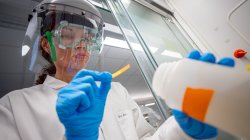
As temperatures soared in July to the hottest in Earth’s modern history, Emily Cepin toiled inside a Montclair State University lab gaining insights into today’s climate crisis by extracting pollen fossils from rock sediment formed 56 million years ago. The work is both tedious and timely. “If we don’t do something soon, it’s going to be that much harder to overcome and it’s going to lead to severe and consequential events,” she says.
Cepin’s research looks at how plants and vegetation are changing today compared to a long ago extreme climate event, the Paleocene-Eocene Thermal Maximum (PETM), a geologic period of intense global warming. To analyze pollen from that period she removes minerals like carbonates and silicates from ancient rocks using a series of chemical reactions.
“Analyzing the pollen samples will allow me to understand how plants and vegetation responded to the PETM event and compare it to how plants are changing in response to the current climate crisis,” explains Cepin, a senior Earth and Environmental Science major mentored by Assistant Professor Ying Cui.
Cepin’s research is among nearly 40 projects underway this summer conducted by Montclair undergraduate students. The student researchers are tackling some of the world’s toughest scientific and engineering challenges, everything from finding a cure for malaria to building technology for classrooms and protecting swimmers from jellyfish in the coastal bays of New Jersey.
“The commonality,” says Chemistry and Biochemistry Professor Yvonne Gindt, “is that these students have research mentors who care deeply about making them into the next generation of scientists.”
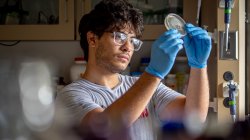
The undergraduate research program is supported by a combination of funding. More than half of the students receive stipend support from the National Science Foundation Garden State LSAMP (Louis Stokes Alliance for Minority Participation) program, an alliance of New Jersey universities to broaden participation of underrepresented groups in science and engineering research. This support is matched by a New Jersey Opportunity Meets Innovation Challenge Grant and generous donations by alumni and friends of the University who support student experiential learning.
“The program focuses on teaching the students what it means to be a scientist, understanding their professional obligations and understanding what scientists really do,” says Gindt, who helps oversee the program.
As a comprehensive public research university, Montclair provides opportunities for students to work in labs early in their undergraduate studies. “I started doing little things, weighing sediments or helping with graduate-level work my freshman year and slowly progressed,” says Cepin. She has presented her work to the Geological Society of America, and in 2022 won the University’s Mario M. Casabona Future Scientists competition for her ability to explain her scientific research to the general public and non-science professionals.
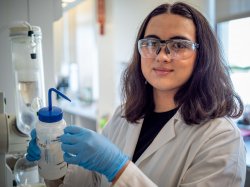
Faculty members play a key role in identifying and training undergraduates. “I encourage them to think on their own because that’s where the real creativity comes from,” says Chemistry and Biochemistry Professor David Rotella, director of the Sokol Institute for Pharmaceutical and Life Sciences.
“Professors know that you’re new and that you’re learning,” adds Rachel Gushikem, a junior Biochemistry major mentored by Rotella. “They’re excited about being a part of your process, which makes it easy to have the vulnerability to try new things in the lab and be unafraid to ask the questions you need to ask to grow as a scientist.”
The students’ research choices reflect what they care about and problems they want to solve. “That’s where the passion comes from,” observes College of Science and Mathematics Dean Lora Billings. “Our faculty are very good at keeping projects moving, at teaching students resilience and persistence, and when things don’t go as planned, that there’s always a silver lining in there somewhere.”
Noah Ramadan, senior Biology major, is comparing the genetic information of a virus discovered at Montclair to a closely related species. “Scientists have been able to determine with some confidence the identity of the genes that comprise the genome. But until those genes are produced in the lab as proteins and we analyze those proteins, we can’t say with confidence that one protein is what we think it is,” explains Ramadan, who is mentored by Biology Professor Quinn Vega.
“Our goal is to take these viral genes, produce their protein products and see what they are for the purposes of identifying them. Once we have identified them, it gives us a lot of room for experimentation,” Ramadan says.
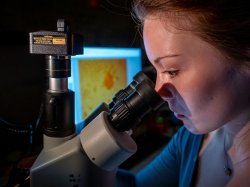
Rylee Allen, a sophomore Biology major, is studying how fast clinging jellyfish polyps clone themselves under different salt environments to try and pinpoint where they might be most abundant in the wild.
Jellyfish polyps are small and hidden, so it is almost impossible to find them. However, understanding the environment that they grow best in will help identify areas where the polyps survive and thrive, she says of the research mentored by Biology Professor Paul Bologna, director of the Marine Biology and Coastal Sciences program.
Since the polyp stage survives the winter and makes the next years’ adult jellyfish, knowing where the polyps are could help find ways to minimize or eradicate this invasive species, while protecting families enjoying the coastal bays of New Jersey.
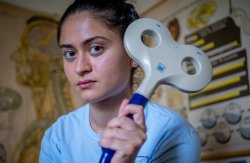
The full-time summer research positions give students the time to delve deeply into the work. “During the school year, you’re trying to balance your classes and research. But in the summer you can focus on the research that you’re doing. It’s definitely a different experience,” says Athenia Ibragimov, a senior Biochemistry major.
Ibragimov says she appreciates the mentorship from Biology Professor Julian Keenan, director of the Cognitive Neuroimaging Laboratory. “I’ve made some mistakes, like anyone. It’s definitely nice for someone to point that out to you, but in a way that’s constructive, so you don’t make those mistakes again. Ultimately you become a better student, a better researcher and a better leader.”
A sampling of other work taking place at Montclair this summer includes:
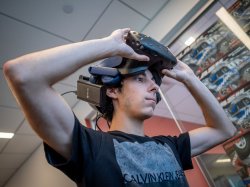
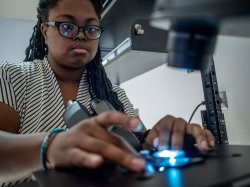
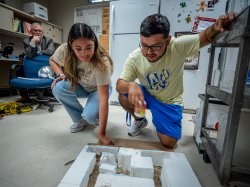
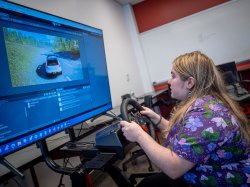
The undergraduate research training is just part of the science happening on campus this summer:
- Eco-Explorers, run by Montclair’s New Jersey Center for Water Science and Technology. The program connects students from underserved communities to the natural world, including hands-on experience about ecology, environmental science and sustainability.
- The Weston Science Scholars is a summer experience for high-achieving students from Montclair High School. The students study marine biology, physics, genomic sequencing, cybersecurity, magnetic imaging and more.
- The Green Teams internship program run by the Montclair-based PSEG Institute for Sustainability Studies supports research and community projects, including climate change in New Jersey, and energy and water studies globally.
- New Jersey teachers receive professional development to learn how to increase computer science offerings in elementary education.
Field research is also part of the summer mix. Outside of the lab, Cepin has waded into the waters near campus to assess the impact of urban pollutants on the 21-acre Alonzo F. Bonsal Wildlife Preserve on the Montclair and Clifton border. Students used heavy-duty surveying and geophysics equipment, tools they will likely use in careers in urban environmental geology.
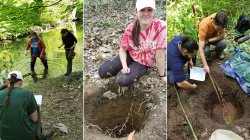
“There are hiking trails and a lot of people use the preserve to walk their dogs. We were getting questions from them: ‘What are you guys doing? Why do you have all these machines?’
“I get excited when people who don’t know about science get excited,” Cepin says.
Story by Staff Writer Marilyn Joyce Lehren. Photos by University Photographer Mike Peters.
You May Also Like:
